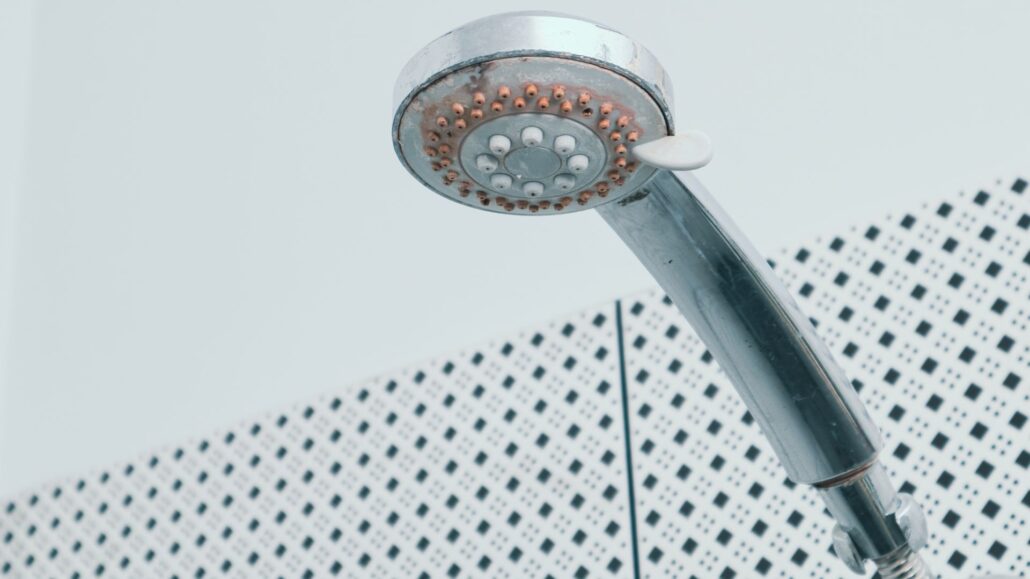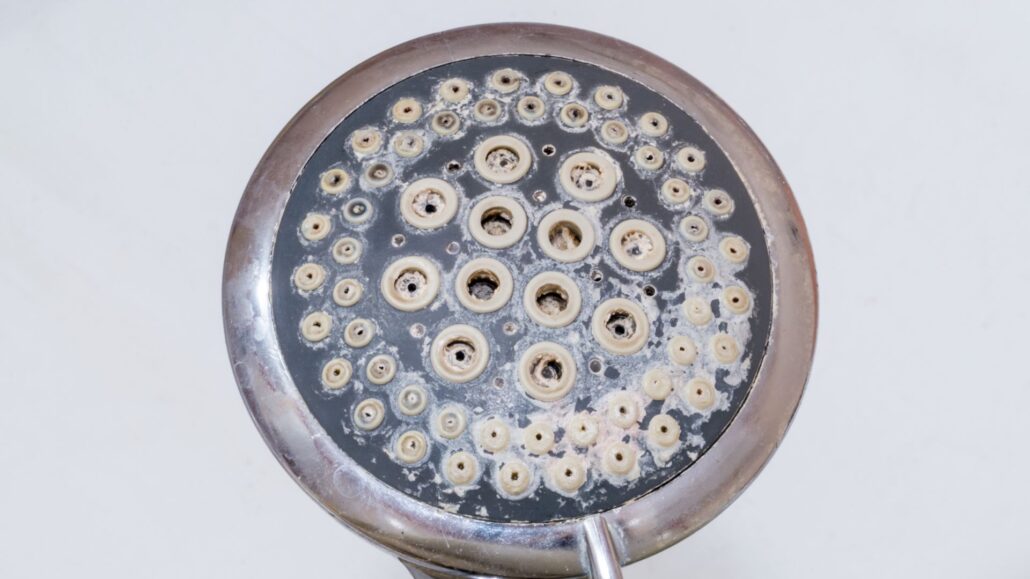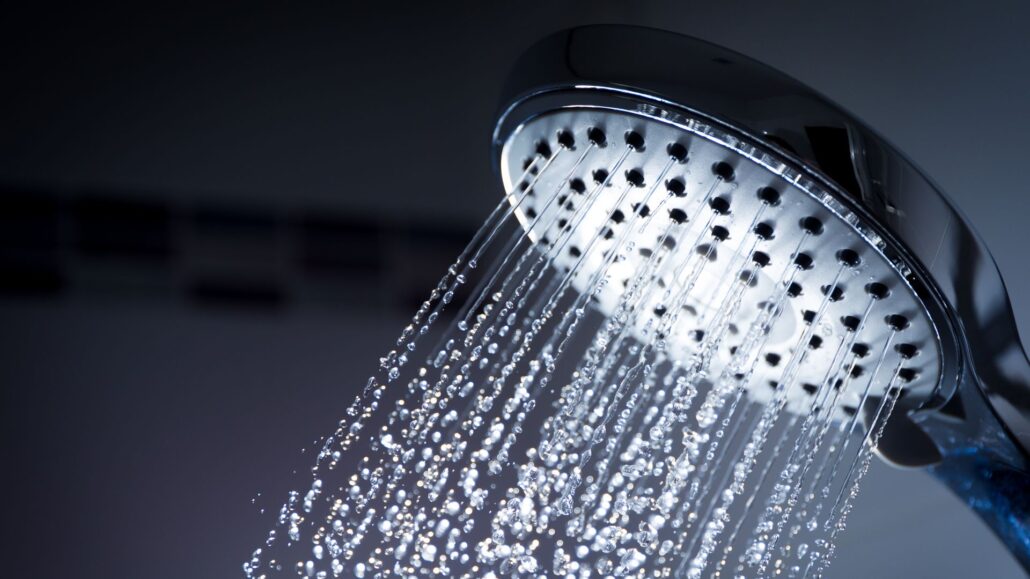Hard water that is high in minerals like calcium and magnesium causes annoying limescale build-up in shower heads over time. As you shower with heated hard water, the minerals bind together and attach to the shower head, forming crusty deposits that clog nozzle holes and coat the shower head surface.
This mineral build-up severely reduces water pressure and flow coming from the shower head. Instead of a strong stream, you get weak, dripping shower spray. Removing existing mineral deposits and taking proactive steps to prevent future build-up is crucial for maintaining proper shower head function and enjoyment.
Keeping your shower head clear of limescale restores strong water flow and pressure for a more satisfying showering experience. To improve the comfort of daily showers, preventing and removing mineral deposits should be a priority for homes with hard water.
What Causes Mineral Build-Up on Shower Heads?
The mineral deposits that accumulate on shower heads are caused by hard water, which contains high concentrations of calcium, magnesium, and other minerals. Hard water is most prevalent in areas with limestone, chalk, or other sedimentary rock formations, which leach minerals into the water supply.
When hard water is heated, such as in water heaters, the minerals become even more inclined to bind together and attach to surfaces. So, showering with hot, hard water accelerates the rate of mineral deposits.
As the mineral-rich hot water flows through the shower head, the minerals start adhering to the internal parts and nozzle holes. Over time, these minerals build up in layers, forming limescale. Limescale is the chalky white crust that coats shower heads and clogs nozzle holes when minerals continuously bind together.
In addition to calcium and magnesium, other minerals commonly found in hard water include manganese, iron, copper, and zinc. However, calcium is typically the main component of limescale. All of these minerals from the hard water source deposit faster when heated and attach to shower head surfaces.
The harder your home’s water supply, the more prone shower heads are to developing significant mineral build-up issues over time. Soft water contains fewer minerals, so there is less depositing. However, areas with very hard tap water will see heavy limescale accumulation on shower heads and other plumbing fixtures.

Signs of Mineral Build-Up
There are several clear warning signs that indicate problematic mineral deposits are accumulating on your shower head:
- Decreased water pressure – The shower spray will feel noticeably weaker, and you’ll have to turn the shower handle much more to get the same water flowing out of the shower head.
- Weaker water flow – Your showers become less satisfying as the water flowing out of the shower head is reduced by the clogged nozzle holes.
- Cloudy spray instead of a strong stream – With excessive mineral build-up, the normal solid stream of water gets dispersed into a weaker, mistier spray.
- White/brown mineral residue around nozzle holes – Upon close inspection, you’ll notice crusty mineral deposits clustered around the nozzle openings.
- Spotty limescale visible on shower head surface – Looking closely at the shower head face, you’ll see white/tan mineral crust coating the nozzles and the entire front surface.
These symptoms mean limescale build-up has already begun clogging your shower head and reducing function. Taking action to remove deposits as soon as possible will restore normal shower power.
Removing Existing Mineral Deposits

Removing the accumulated limescale deposits is crucial to restoring normal function and water flow if you notice decreasing water pressure or other signs of mineral build-up on your shower head. There are several effective methods for removing existing mineral build-up:
Vinegar soak
Fill a bowl, bucket, or plastic bag with undiluted white vinegar and completely submerge the shower head in the vinegar overnight or for several hours. The acetic acid in the vinegar will work to dissolve and dissolve the limescale naturally.
CLR cleaner
Spray calcium, lime, and rust-removing formula liberally over the shower head surface and crevices to saturate the nozzles. Let the cleaner sit for 5-10 minutes before scrubbing with a small brush to clean even tough mineral deposits.
Baking soda and vinegar paste
Make a gritty paste by mixing equal parts baking soda and vinegar. Spread the paste thoroughly over the shower head and let it sit for 10-15 minutes before scrubbing off to lift away the crusty build-up.
Lemon juice and vinegar
Soak a clean cloth in a mixture of lemon juice and vinegar in equal parts. Wrap the juice-soaked cloth completely around the shower head. Let it sit for 30 minutes before unwrapping and scrubbing away dissolved minerals.
Descaling filter
This plastic filter attaches to the shower pipe/head and contains a citric acid tablet that dissolves over time to remove and prevent limescale. Let it soak for a few hours before rinsing.
Thoroughly rinsing and scrubbing the shower head after applying these acid solutions will remove even stubborn surface mineral deposits.
Preventing Future Mineral Build-Up

Once you’ve put in the effort to remove the existing limescale deposits from your shower head, you’ll want to take measures to prevent the mineral build-up from returning and clogging up your shower head again. One of the most thorough and convenient options is installing a whole house water softening system professionally.
This will filter out the hard minerals from all of the water entering your home, preventing limescale from entering not just the shower but also all plumbing fixtures. While the initial installation cost is an investment, the ongoing maintenance of a whole house system is relatively low.
Another targeted option is to attach a shower head water softening filter to the pipe right before the shower head. This selectively filters just the water going to the shower, removing minerals before they have a chance to cause deposits on the shower head itself.
Shower water softeners are easy to install yourself and just require replacing the filter cartridges periodically. For a simpler solution, you can periodically fill a plastic bag with undiluted white vinegar and soak the shower head to dissolve any new mineral deposits before they build up too much.
Make it part of your regular shower cleaning routine. Vinegar rinses every 2-3 weeks can keep limescale at bay. You can also choose shower heads designed to inhibit mineral build-up, with a non-stick coating or rubber nozzles that don’t easily collect deposits.
Wiping down the shower head and drying it thoroughly after each use will also limit mineral depositing by removing lingering water droplets before they evaporate and deposit minerals.
When to Call a Professional
While DIY methods can resolve many mild mineral deposit issues, there are some severe build-up situations where calling a professional plumber is advisable. If the shower head is extremely difficult to unscrew and remove from the pipe for cleaning due to excessive mineral blockage in the connecting joints, a pro may be needed to break it free.
If the limescale is not isolated to just the shower head and you’re noticing significantly reduced water pressure from all faucets due to mineral deposits forming deep in the home’s pipes and plumbing, a whole-house descaling by a plumber might be necessary.
Additionally, professional expertise is recommended for proper installation and functioning if you want to install a whole-house water softening system to filter hardness minerals from your entire water supply.
Calling a plumber is also a good idea if you suspect underlying issues beyond just mineral build-up, like pipe corrosion or other water flow problems needing inspection and repair of your home’s plumbing system.
Clogged shower? Restore the flow with The Brisbane Plumbers
Don’t let mineral build-up reduce your shower satisfaction and pressure. As Brisbane’s top-rated plumbing service, The Brisbane Plumbers have the expertise to efficiently remove limescale deposits and implement systems that prevent future clogging and loss of water flow. We get your shower back to full power.
Contact us today for quality service to maintain your plumbing and promote proper water flow throughout your home. The Brisbane Plumbers – for showers you can enjoy again.
